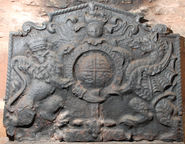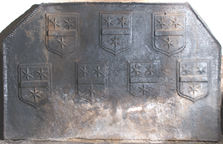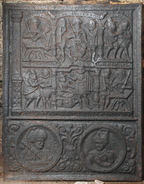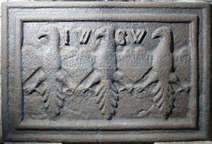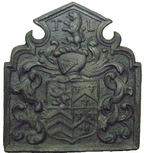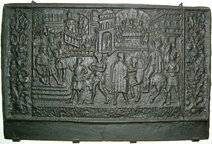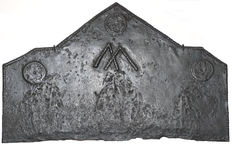-
692
Description: Rectangular with inclined sides, joined by scrolls to a pedimented top; twisted rope edging (top and sides); Garter enclosing the Tudor royal arms, with crowned lion and dragon supporters, helm with chapeau and lion crest, and mantling; rectangular date compartment at base; initials either side of crest.
Notes: The detached pediment is stylistically typical of the late-16th and early-17th centuries. The use of a chapeau or cap of maintenance in place of a crown above the helm is rare in this period. There is an excrescence on the casting over the jaws of the dragon caused by the pouring of the molten metal disturbing the sand mould.
Inscription: E R / Garter motto / 160[?0]
Arms: Tudor royal - Elizabeth I
- Decoration tags:
- rectangular with detached pediment (shape)
- rope (edging)
- whole carved pattern
- individual letters
- individual numbers
- armorial
- royal
- text
Manufactured: in 1600 in England.
Current location: Cothay Manor, Stawley, Somerset, England.
- Attached to series:
- Elizabethan royal armorial firebacks
- Tudor royal armorial firebacks
-
693
Description: Canted rectangle; twisted rope edging (top and sides); a shield repeated five times, each bearing three arrows palewise, points down, with a molet (star) above the middle arrow, two over three.
Notes: Three arrows form the arms of several families, so identification of the arms is not possible without the associated colouring. The star is likely to be a mark of cadency, granted to a third son. Four rivets along the base may relate to earlier repair. The fireback was formerly at Chisenbury Priory, Wiltshire. A variant with three shields (W 740mm x H 480mm) was lot 530 at Brettells auction, Newport, Salop, 1 March 2022 and again as lot 457 on 2 May 2023.
Arms: Not known
- Decoration tags:
- rectangular with canted top corners (shape)
- rope (edging)
- carved stamps
- armorial
Manufactured: in the late-16th to early-17th century in England.
Current location: Cothay Manor, Stawley, Somerset, England.
- Attached to series:
- Personal armorial firebacks
-
958
Description: Rectangle with triangular arch; twisted rope edging (top and sides); centre top, initials in triad, E above; two twisted rope crosses irregularly spaced below initials.
Notes: The initials, probably of a husband and wife, show minimal extension in the horizontal, although the 'I' has a stud halfway; the crosses almost certainly have an apotropaic purpose; the depth of the casting varies between the top, where it is thickest, and the bottom. Bellman's auction, Wisborough Green, 13 Oct 2021, lot 589 (£420).
Inscription: IEL [triad]
- Decoration tags:
- rectangular with triangular arch (shape)
- rope (edging)
- simple stamps
- carved stamps
- apotropaic
- text
Manufactured: in the late-16th to early-17th century in England.
Current location: not known.
- Attached to series:
- Rope design firebacks
-
722
Description: Canted rectangular shape; twisted rope edging (top and sides); shield with recessed edges repeated seven times (3 and 4): a fess between three mullets of six points.
Notes: The arms are those of Courthope of Whiligh in Ticehurst; blazon: argent, a fess azure between three estoiles sable (two and one). Shown are molets of six points which have straight rays instead of (properly) estoiles which have wavy ones. However, the 1643/4 iron graveslab of David Barham of Snape, in Wadhurst church, has the same arms (also with molets instead of estoiles), which were those of his mother who was a Courthope.
Arms: Courthope, of Whiligh in Ticehurst
- Decoration tags:
- rectangular with canted top corners (shape)
- rope (edging)
- carved stamps
- heraldic
- armorial
Manufactured: in the late-16th to early-17th century in the Weald area of England.
Current location: in private hands, Ticehurst, East Sussex, England.
- Attached to series:
- Personal armorial firebacks
- Courthope arms series
-
705
Description: Stove side plate; cavetto moulded edging; upper panel, Ionic column and pedestal to left; six courtly scenes separated by arches and columns; lower panel, two circular frames, each with a figure, male to the left, female to the right, decorative scroll work between.
Notes: Possibly a graphic retelling of the parable of the Unjust Steward (Luke 16: 1-13)
Inscription: [illegible]
- Decoration tags:
- rectangular (shape)
- flanged (edging)
- whole carved pattern
- pictorial
- biblical
- text
- humans
Manufactured: in the late-16th to early-17th century possibly in the Eifel area of Germany.
Current location: Tiverton Castle, Tiverton, Devon, England.
- Attached to series:
- Stoveplates
-
1160
Description: Rectangular, with double astragal edging; three eaglets, their wings outspread, side by side; the initials IW and SW, respectively, to left and right of the central eaglet's head.
Notes: The design is based on the arms of Wynn, of Gwydir Castle in the Conwy valley of North Wales, the blazon of which is Vert, three eagles displayed in fess or. The initials relate to Sir John Wynn (1553-1626/7) who, c.1576, married Sydney Gerrard (d.1632), dating the fireback to c.1576-1626. The conjoined wings of the eagles appear to form heart shapes.
Inscription: IW SW
Arms: Wynn of Gwydir
- Decoration tags:
- rectangular (shape)
- astragal (edging)
- whole carved pattern
- individual letters
- heraldic
- text
- animals
Manufactured: in the late-16th to early-17th century in England.
Current location: Gwydir Castle, Trefriw, Conwy, Wales.
- Attached to series:
- Personal firebacks
- Welsh armorial firebacks
-
1202
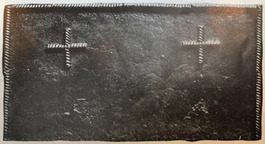 ? x ? mm
? x ? mmDescription: Rectangular shape; twisted rope edging (top and sides); upper centre, two evenly-spaced, medium-sized twisted rope crosses.
Notes: Formerly (1950) at Maidstone, Kent. Illustration from Schubert, 1950.
- Decoration tags:
- rectangular (shape)
- rope (edging)
- simple stamps
- apotropaic
- objects
Manufactured: in the late-16th to early-17th century possibly in the Weald area of England.
Current location: not known.
Citation: Schubert, H. R., Aug 1950, ‘Old English Iron Firebacks’, Steel News, 2, 2, p. 8.
- Attached to series:
- Rope design firebacks
-
908
Description: Quasi arched rectangular shape with detached pediment above symmetrical ‘horns’ within arcs; cavetto-moulded edging; shield with helm, crest and mantling; initials split by crest.
Notes: Blazon: quarterly 1st lion rampant (poss. Lewis, descendant of Gwaethfoed); 2nd a chevron between three fleurs de lys (descendant of Einon ap Collwyn); 3rd three chevronels (descendant of Iestyn ap Gwrgan); 4th as 2nd (but possibly different tinctures); crest: a lion rampant; the initials suggest the arms may be of a member of a cadet branch of the Lewis family.
Inscription: T L
Arms: Possibly a member of the Lewis family
- Decoration tags:
- rectangular with detached pediment (shape)
- cavetto (edging)
- whole carved pattern
- armorial
- text
Manufactured: in the late-16th to early-17th century in Wales.
Current location: Ty-r-ash, Brecon Road, Crickhowell, Powys, Wales.
- Attached to series:
- Personal armorial firebacks
- Welsh armorial firebacks
-
729
Description: Rectangular; flanged edge; central pictorial panel illustrating Mordecai arriving before King Ahasuerus, Haman hanging from the gallows behind; two floral side panels, at the top of each a monogram within a cartouche: on the left KS, on the right H?D; plain extension panel at bottom.
Notes: Stoveplate; the scene illustrates a scene from Esther 7: 10 and 8: 1.
Copies of this fireback are known.
Inscription: KS H[?]D
- Decoration tags:
- rectangular (shape)
- flanged (edging)
- whole carved pattern
- extension panels
- pictorial
- biblical
- architectural
- text
- animals
- humans
Manufactured: in the late-16th to early-17th century possibly in the Eifel area of Germany.
Current location: Victoria & Albert Museum, Cromwell Road, Kensington & Chelsea, Greater London, England.
Museum number: M.112-1953 (part of the Victoria & Albert Museum museum group)
- Attached to series:
- Stoveplates
- Esther stoveplates
-
733
Description: Rectangular with canted top corners and a triangular extension from the top edge; twisted rope edges to all sides except bottom; a circular wafering iron or butter mould stamp, incorporating a square design with a fleur-de-lys on each side, repeated thrice, one at the apex and one below each of the canted corners; two inverted ‘V’ rope shapes overlapping to make an ‘M’ below top stamp.
Notes: The inverted double 'V' may be apotropaic, invoking the protection of the Virgin Mary; the circular stamp has also been noted on a Pelham-associated fireback of 1642 (no. 1204) which may suggest that it was a product of one of the family's ironworks.
- Decoration tags:
- rectangular with triangular arch (shape)
- rope (edging)
- simple stamps
- apotropaic
- objects
Manufactured: in the late-16th to early-17th century possibly at Waldron Furnace in the Weald area of England.
Current location: Victoria & Albert Museum, Cromwell Road, Kensington & Chelsea, Greater London, England.
Museum number: 895.1901 (part of the Victoria & Albert Museum museum group)
Citation: Page, S. & Wallace, M. (eds.), 2018, Spellbound (Oxford, Ashmolean Museum), p. 72.
- Attached to series:
- Food mould stamp firebacks
- Rope design firebacks
